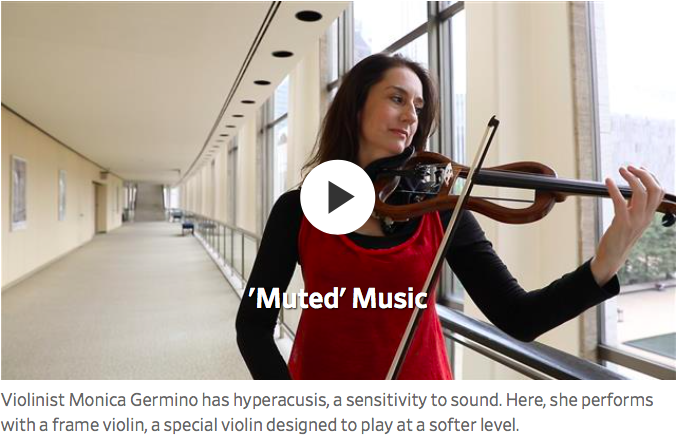A violinist with a sensitivity to sound will perform ‘Muted,’ a special, quieter piece for audiences in Brooklyn
click for WSJ video excerpt
In her decadeslong career, the violinist and contemporary-music specialist Monica Germino has worked alongside major composers, co-founded an international ensemble and performed at venues world-wide.
But in recent years, her life has been derailed by a disorder that connects in the most direct way to her profession: Ms. Germino has hyperacusis, a sensitivity to sound.
The violinist’s solution? She is going the quiet route, performing music specifically written for her with the auditory condition in mind, and asking audiences to join her on the journey.
On Monday and Tuesday, Ms. Germino, who is based in Amsterdam, will offer the U.S. premiere of “Muted,” a piece co-commissioned by the New York Philharmonic with four other musical organizations, at National Sawdust, the Brooklyn venue that specializes in innovative work.
“It’s borne out of necessity,” said Ms. Germino of the piece. But at the same time, “something incredible can happen” musically from such circumstances, she said.
The connection to the Philharmonic stems from the fact that it is currently honoring the Dutch composer Louis Andriessen, who is a fellow countryman of Jaap van Zweden, the orchestra’s newly installed music director. Mr. Andriessen, who is married to Ms. Germino, is one of four composers who contributed to “Muted.”
But it is another contributing composer, New York-based Michael Gordon, who came up with the idea for the work. When he learned in 2016 that Ms. Germino had stopped performing altogether because of her disorder, “I said, ‘You can play quiet music. We’ll write you the quietest piece ever written,’” Mr. Gordon recalled.
Ms. Germino helped the process along by using special violins that are designed to play at a softer level or adapting a traditional violin with the use of mutes – essentially, a device that causes the strings to vibrate less. She has also had a new instrument, dubbed a whisperviolin, made for her.
The composers involved explain that “Muted” isn’t necessarily difficult for audiences to hear. Mr. Gordon said concertgoers just need to pay closer attention. He likens it to stepping into a dimly lit room and adjusting your eyes until you can see clearly once again.
While Ms. Germino may have found a way to adapt to her situation, she is far from the only musician to contend with hyperacusis, which is often associated with exposure to loud sound. Indeed, musicians are “fundamentally at higher risk” for the condition, said Bryan Pollard, founder and president of Hyperacusis Research, a U.S. nonprofit organization.
At its most extreme, the condition can cause those who suffer from it to experience pain when they hear noise or certain sounds, say experts. Ms. Germino said in her case, she is just “very sensitive” to loudness.
But she had been advised by auditory professionals to quit playing or wear earplugs, lest she risk damaging her hearing. Neither of those options proved suitable, so that led to her current solution.
Regardless of her condition, Ms. Germino thinks there may be a broader benefit to turning down the volume and seeing the value in the quiet.
“We are so swamped with sound and overstimulated,” she said.

